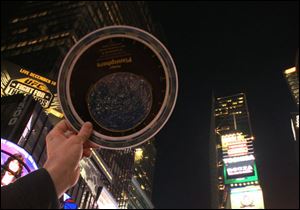
Documentary studies effect of city lights
5/15/2012
A screen shot showing New York City in a scene from ‘The City Dark.’
To fully experience the brilliance of a starry night, it's necessary to leave the city's impermeable glow and seek out a secluded patch of countryside, miles away from a neighboring light source.
But the growing glare of city light pollution is making these oases of dark increasingly rare -- for us and for astronomers.
"What do we lose when we lose the night?"
Filmmaker Ian Cheney (King Corn) explores that question in his 2011 documentary The City Dark, playing at University of Toledo's Ritter Planetarium.
Astronomers, including the popular Neil deGrasse Tyson, offer thoughtful commentary (much of it surprisingly warm and funny) about humanity's historical relationship with the cosmos, and ponder what we as a species lose when that nightly connection is broken by a man-made "dome of light" caused by light reflections on dust and other particulates in the atmosphere.
But the increasing light of our world is troubling in ways beyond our obstructed view of the heavens.
For humans, the additional lights mean a substantial decrease in melatonin, which the body produces in the absence of light. Scientists are investigating the health ramifications of the decline of melatonin in the body, including the potential higher risk of cancer; the World Health Organization has already declared shift work -- meaning those who work at night and sleep during the day -- as a carcinogen.
Just as sobering is how this unnatural abundance of light is affecting nature.
Sea turtles in Florida have been conditioned over millions of years to look for the glow of light over the ocean to guide them to water after hatching; however, the illumination of the city is redirecting newborn turtles away from the water, leading to the deaths of thousands of these endangered species each year. Birds, which rely on the stars as a navigational tool during migrations, are drawn to the bright cities; an estimated billion birds a year die after smashing into buildings. The population of fireflies, which rely on the dark for mating, are also on the decline.
Cheney was an amateur astronomer who grew up in a small rural town in Maine blanketed at night by deep-black skies, stars, and the wispy interstellar clouds of our Milky Way galaxy. He lost that view when he moved to New York City, where only the moon and a few of the night's brightest stars can compete with the millions of man-made lights. That's what led him to make The City Dark.
It's a thoughtful documentary clocking in at less than 90 minutes that explores an abundance of topics and issues associated with light pollution -- some obvious, some seemingly unconnected -- illuminating a problem most of us have never considered.
The City Dark is playing 7 and 9 p.m. Saturday and May 26 at the University of Toledo's Ritter Planetarium, located on UT's main campus, on the first floor of the Ritter Astrophysical Research Center. Tickets are $7 for adults and $5 for children 4 to 12, senior citizens, and UT faculty, staff, and students, and free for children 3 and younger. For more information, call Ritter Planetarium at 419-530-2650 or its 24-hour information hotline at 419-530-4037, or visit http://tinyurl.com/6llau68.
Contact Kirk Baird at kbaird@theblade.com or 419-724-6734.